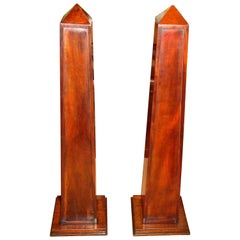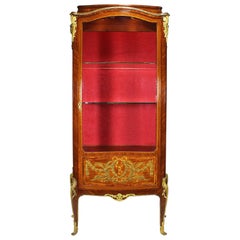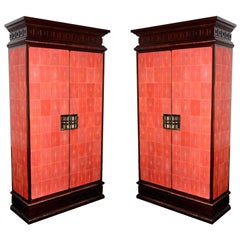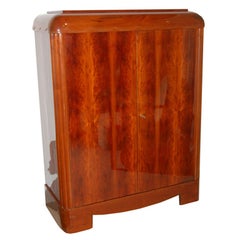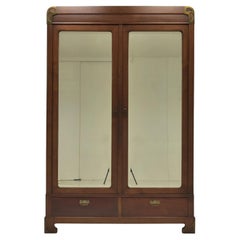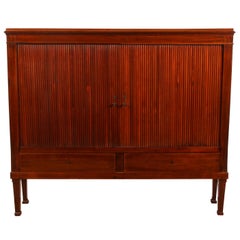Mahogany Cabinets
Color: Red
Material: Mahogany
Pair of Mahogany Obelisks with Shelves
Located in Mt Kisco, NY
A pair of mahogany obelisks on platforms. One side opens to reveal graduated shelves.
Category
Early 20th Century Unknown Mahogany Cabinets
Materials
Mahogany
19th-20th Century Marquetry and Gilt-Bronze Mounted, François Linke Atrributed
Located in Los Angeles, CA
A fine French 19th-20th century kingwood and tulipwood marquetry and gilt-bronze mounted vitrine, in the manner of François Linke (1855-1946). The slender single door display cabinet with a red-velvet backing and bowed glass panels surmounted with acanthus and floral gilt-bronze mounts in the style of Léon Messagé (French, 1842-1901), the serpentine shaped front door with an ornate marquetry and ink colored panel depicting wreaths, ribbons and tied acantus leaves, all raised on four cabriolet legs ending with gilt-bronze paw-feet, Paris, circa 1900.
Linke was born on 17 June 1855 in the small village of Pankraz, in what is now the Czech Republic. Records show that Linke served an apprenticeship with the master cabinet maker, Neumann, which he completed in 1877. Linke’s work book or Arbeits-Buch records that he was in Vienna from July 1872 to October 1873 at the time of the International Exhibition held there in 1873.
He subsequently travelled to Prague, Budapest & Weimar before finally arriving in Paris in 1875. It is documented that he obtained employment with an unknown German cabinetmaker in Paris, and stylistic similarities, photographs and geographical proximity have led some to suggest that Emmanuel Zwiener was the most likely candidate. After a period back in his home town of Pankratz, he returned once and for all to Paris in 1877. In 1878 Paris hosted the third great International Exhibition, a remarkable success for a country ravaged by war only seven years earlier. It is known that the fledgling Linke workshops were active in the Faubourg St. Antoine as early as 1881, during this time he supplied furniture for other more established makers such as Jansen and Krieger.
By 1889 another World’s Fair, as they were often referred to in America, took place in Paris. Monsieur Eiffel erected what has become the most iconic building in Paris for the exhibition and the atmosphere of wealth and confidence may well have encouraged Linke to think that he could contribute an important part to the next great exhibition. As early as 1892 this was decreed to take place at the end of the century, in an attempt to pre-empt Berlin from staging the last great show of the century.
In 1892, Victor Champier (fr) one of the commissioners for the 1900 Paris Fair had appealed, “Create in the manner of the masters, do not copy what they have made”. It was an appeal against mere reproduction and Linke rose to this challenge in an unparalleled way with his unique display that was to include the Grand Bureau.
Determined to outshine the competition at the Exhibition, Linke had set about creating the most ambitious pieces he could envisage, and more extravagant than had ever been displayed before. The items he exhibited marked a transition from the historicist interpretation of Louis XV and Louis XVI styles, an interpretation that was the mainstay of his nearest rivals, to something startlingly new and vital in its immediacy. [6] Together with Léon Messagé he developed a new style for the 1900 Exhibition that paid homage to the Louis XV rococo in the fluidity of its approach, but an approach fused with the lively flowing lines of the contemporary and progressive 'art nouveau'. The Art Journal reported in 1900 on Linke's stand:
"The work of M. Linke ... was an example of what can be done by seeking inspiration amongst the classic examples of Louis XV and XVI without in any great sense copying these great works. M. Linke's work was original in the true sense of the word, and as such commended itself to the intelligent seeker after the really artistic things of the Exhibition. Wonderful talent was employed in producing the magnificent pieces of furniture displayed".
Linke's stand would have appeared refreshingly new to contemporary onlookers, the traditional designs of the eighteenth century melting seamlessly into an exuberant naturalism. The 'Revue' described Linke's style as 'entièrement nouveaux' and noted "This opinion is universally accepted. Linke's stand is the biggest show in the history of art furniture in the year 1900". It is perhaps the most extraordinary and remarkable aspect of Linke’s personal history that he produced such expensive and luxurious furniture of exquisite quality for the 1900 exhibition without any commission or any potential buyer in mind. [9] At a time when other more established furniture businesses such as those of Beurdeley and Dasson were closing down, he made a huge investment in his stand and the furniture he supplied for it. Linke recognised that to move his business forward he needed to appeal to a more International clientele and the new emerging rich who were at this time amassing fortunes on an unprecedented scale. For this reason he gambled everything he had on his display for the 1900 exhibition. Had this not succeeded he would almost certainly have succumbed to bankruptcy. Linke’s notebook records visitors to his stand from England, Europe, the Americas, Egypt and Japan and including; the King of Sweden, three visits from the King of Belgium, Prince Radziwill, the Prince d’Arenberg, the Comte Alberic du Chastel, Miss Anna May Gould, the American heiress, distinguished furniture makers and the President of France Emile Loubet.
This risky endeavour was a resounding success, and with his reputation established, La Maison Linke became the pre-eminent furniture house until outset of the Second World War. The technical brilliance of his work and the artistic change that it represented was never to be repeated. His showrooms expanded into prestigious premises in Paris, in the Place Vendôme as well as the Faubourg St. Antoine where his workshop had been established. He embarked on many important commissions in the years up to the outbreak of the First World War, making and designing furniture for leading international industrialists and bankers. After the 1914-1918 World War, Linke undertook the extraordinary commission to furnish the Ras al-Tin Palace in Alexandria for King Fuad of Egypt, possibly the largest single furniture commission ever conceived, eclipsing even Versailles. Linke flourished and remained active until the middle years of the 1930s and died in 1946
Léon Messagé (1842-1901) was a French sculptor, best known for his sculptural collaboration with François Linke for the 1900 Paris Exposition Universelle. Messagé was also responsible for much of the design and creative work for Roux et Brunet...
Category
Early 1900s French Louis XV Antique Mahogany Cabinets
Materials
Bronze
Cabinet Royal Set of Two in Solid Mahogany and Red Genuine Sharkskin
Located in Paris, FR
Cabinet Galuchat rouge set of two in solid mahogany and red
genuine sharkskin, double handles nickel-plated copper,
with interior shelves with central cushion in fabric and
interior lights. Exceptional piece.
Set of two cabinets...
Category
1990s French Mahogany Cabinets
Materials
Mahogany
Armoire by Louis Sue & Andre Mare
By Andre Mare, Louis Sue
Located in Pompano Beach, FL
2 door Art Deco solid mahogany and burl armoire w/3 drawers inside by Louis Sue (1875-1968) & Andre Mare (1885-1932)
Category
1930s Vintage Mahogany Cabinets
Materials
Burl, Mahogany
Related Items
Gilt Bronze Mounted Vitrine by François Linke
Located in Ciudad Autónoma Buenos Aires, C
Louis XV style vitrine by François Linke (1855 - 1946) Made of gilt bronze mounted wood, with a violet breccia marble top, front and beveled glass pa...
Category
19th Century French Louis XV Antique Mahogany Cabinets
Materials
Bronze
Art Nouveau Hallway Cabinet in Mahogany, 1920
Located in Lüdinghausen, DE
Hallway cabinet restored Art Nouveau around 1920 mahogany cabinet
Features:
Two-door model with clothes rail and two drawers
Very high quality processing
Original bar lock
Original faceted mirrors
Beautiful brass applications
The right drawer was missing and was rebuilt
Drawer fittings renewed in keeping with the style
Quite reduced, factual Art Nouveau design
Design according to previous owner by Albert van Huffel...
Category
20th Century Art Nouveau Mahogany Cabinets
Materials
Mahogany
19th Century French Vitrine of Kingwood and Gilt Bronze Mounts
Located in London, GB
A fine vitrine in the manner of Francois Linke
Constructed in kingwood, with gilt bronze mounts, in the Louis XVI Transitional style; rising from bronze foliate sabots, with gent...
Category
19th Century French Louis XVI Antique Mahogany Cabinets
Materials
Marble, Bronze
Italian 18th Century Wrought Iron Studded Antique Safe Strong Box
Located in Carimate, Como
This beautiful Italian antique safe is a collector piece with typical all-around hobnails, dated circa 1820-1840, has a great metal color with patina of time and amazingly rich decor...
Category
Late 18th Century Italian Industrial Antique Mahogany Cabinets
Materials
Metal, Wrought Iron
Antique Scottish Armoire
Located in Malibu, CA
This antique armoire is made from beautiful hardwood and burled walnut veneers. Easy to move and assemble, it is constructed from six separate pieces that stack together. There are two tall wardrobes on each side flanking the center sections. The wardrobe sections have dowels for hanging clothes and small drawers at the bottom. The top center section has locking doors which open to a single compartment. It is large enough to hold a small sound system or tv, and there is a small hole cut in the back for wiring. The lower center section consists of five 5 large graduating drawers. The top drawer has 2 dividers to create 3 sections. All drawers are lined with gilded multi-color Florentine paper...
Category
Late 19th Century Scottish Georgian Antique Mahogany Cabinets
Materials
Walnut, Hardwood, Paper
Danish Teak Floating Wall Shelves/Nightstands - Pair
Located in Brooklyn, NY
Pair of single-drawer floating nightstands or wall shelves, with black painted tops and brass drawer pulls. Danish, mid-century.
Category
Mid-20th Century Danish Mahogany Cabinets
Materials
Teak
André Sornay Highboard in Mahogany and Ash
By Andre Sornay
Located in Waalwijk, NL
André Sornay for Atelier Sornay, wardrobe or armoire, ash, mahogany, France, 1950s
Iconic midcentury wardrobe by French designer André Sornay. With its geometric design and the com...
Category
1950s French Mid-Century Modern Vintage Mahogany Cabinets
Materials
Ash, Mahogany
Antique French Louis XV Carved Walnut 2 Door Armoire w/ Original Mirrors Ca 1900
Located in New Orleans, LA
Antique French Louis XV Style Carved walnut 2 door armoire with Original Curve-Line Beveled Mirrors. Beautiful Fitted Interior.
Category
Early 20th Century French Louis XV Mahogany Cabinets
Materials
Mirror, Walnut
H 95 in W 54 in D 18.75 in
18th Century Ming Chinese Two-Door Cabinet
Located in Pasadena, CA
A lacquer finished 18th century Chinese two-door cabinet with a set of small round legs. This simple and Classic piece comes from Henan Province and contains al original hardware and...
Category
18th Century Chinese Qing Antique Mahogany Cabinets
Materials
Lacquer
Contemporary Brutalist Style Wardrobe in Solid Oak and Linseed Oil
By Sóha
Located in Paris, FR
Wardrobe made of solid oak (+ linseed oil)
Measures:175 x 80 x 40 cm
SÓHA design studio conceives and produces furniture design and decorative obje...
Category
21st Century and Contemporary Russian Brutalist Mahogany Cabinets
Materials
Oak
18th Century French Louis XIII Carved Walnut Armoire Bonnetiere from Perigord
Located in Dallas, TX
This large, elegant antique "bonnetiere" (one-door armoire) would make a beautiful addition to any living room or bedroom! Crafted in the Perigord region of France circa 1750, the si...
Category
Mid-18th Century French Antique Mahogany Cabinets
Materials
Walnut
H 88 in W 42 in D 25 in
Pair of figured mahogany cabinet
Located in Cheshire, GB
Pair of figured mahogany cabinets, the rectangular tops above a pair of well-figured mahogany doors opening to reveal an adjustable shelved interior. The cabinets are adorned with fl...
Category
Mid-19th Century British Antique Mahogany Cabinets
Materials
Wood
Previously Available Items
Period Swedish Empire Bookcase Cabinet Cabinetmaker's Sample
Located in Atlanta, GA
Diminutive glass breakfront cabinet of mahogany with golden birch inlay. Believed to be a cabinetmaker's sample. Back of upper cabinet lined in crimso...
Category
19th Century Swedish Antique Mahogany Cabinets
Materials
Mahogany
Late 19th century Danish Mahogany Book Cabinet
Located in Pasadena, CA
Late 19th Century Danish Mahogany Book Cabinet, having tambour doors that hide two shelves.
Category
Late 19th Century Danish Neoclassical Antique Mahogany Cabinets
Materials
Mahogany
Swedish Mahogany Inlaid Bar / Storage Cabinet
Located in Atlanta, GA
Ribbon mahogany cabinet with golden birch inlay on dark birch stand. Golden flame birch interior doors. Two dove-tailed drawers.
Category
20th Century Swedish Mahogany Cabinets
Materials
Mahogany, Birch
Recently Viewed
View AllMore Ways To Browse
Bamboo Case Piece
Wall Glass Display Cabinet
Century Curio Cabinets
Wooden Corner Cabinet
Century Furniture Curio Cabinets
Blue Display Cabinet
White And Tall And Storage
Barley Twist Cabinet
Black Lacquered Chinoiserie Cabinets
Carved Over Door Painted
Brass Door Pull Hardware
Butterflies In Case
Glass Display Cabinet Sliding Door
Used Oak Filing Cabinets
Wood Relief Door
19th Century Antique Antique Lacquer Cabinet
Custom Wood Interior Doors
Antique Industrial Storage Cabinet
